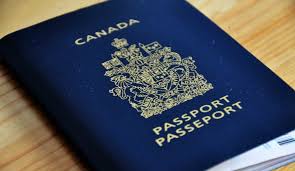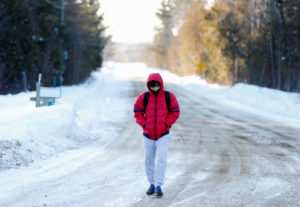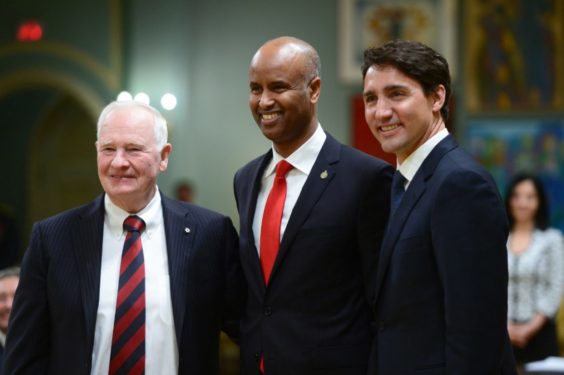Re Ian Bremmer 'Could third-party candidates upend the 2024 US election?' 3 April The current political movement in the USA…
Canada — Immigration & citizenship 2017 – 2019
Written by Diana Thebaud Nicholson // September 16, 2019 // Canada, Immigration/migration // Comments Off on Canada — Immigration & citizenship 2017 – 2019
Fact check: Do refugees get more financial help than Canadian pensioners?
(CTV News) An infographic that has been widely circulated by email and shared on social media claims that Ottawa gives refugees a “monthly pension” of $1,890, plus $580 in social aid, for a total of $2,470 per month or nearly $29,000 per year.
The infographic says that Canadian seniors, meanwhile, cannot receive more than $1,012 per month, or $12,144 per year in Old Age Pension and Guaranteed Income Supplement benefits.
The Government of Canada says those claims are false. (December 2015)
16 September
Scamming your way into Canada is easy. The fix is easy too, if government is willing to act
By Richard Kurland
(CBC SK) Some Canadian employers and their employees conspire against the country’s immigration program. “Paper jobs,” like the one detailed by CBC after a recent undercover investigation, are for sale with price tags typically ranging from $150,000 to $350,000.
After CBC investigated CRA scams in India, that country worked with Canada to help fix it. Hopefully this latest investigation pushes Ottawa to work with China to shut down paper job scams operated from Chinese soil.
The paper job immigration scam is easy.
The foreigner who wants to be an employee hands over cash, some of which covers their own future salary for at least a year of full time employment and the deductions the employer has to pay the CRA.
The employer then doles out cash regularly to the employee’s bank account and to CRA. This creates a fiction of continuous employment in Canada at a specific job at a specific place for at least a year.
The “work experience” from the paper job can then be used to upgrade the employee from a temporary foreign worker to a permanent resident of Canada. The free medical care that comes with being a resident is a bonus.
Immigration officials in Canada know how they could fix this, if they were allowed to. It’s the same tactic in place to prevent immigration via marriage scams.
In a marriage scam, the Canadian spouse receives money for sponsoring the foreigner at a market rate of at least $50,000.
For example, say a foreign student prefers to not pay the $20,000 per year in foreign student fees. They marry a Canadian, getting permanent residence and access to local student fees. Meanwhile, the Canadian gets money to cover their university tuition.
The policy solution to uncover a “marriage of convenience” is simple: the interview. Interview the couple together and separately. Our immigration people are highly trained. It does not take long before stories pop and truth is uncovered.
Toronto immigration firm charges $170K for fake Canadian job, undercover investigation reveals
14 March
William Watson: Now we know how well Trudeau’s Syrian refugees are doing. It’s not good
For government-assisted refugees, the employment rate is less than five per cent
Among Syrian refugees admitted in 2015, however, employment of male refugees who had been privately sponsored was about 55 per cent, which doesn’t seem so bad under the circumstances. For males who were government-assisted, however, and who tended to be the harder cases to begin with, the employment rate was less than five per cent. Syrian refugees were also less likely to be employed than 2015–16 refugees from other countries. In part this was because on average they had been in the country a shorter time, but it was also because their demographic characteristics made them less employment-ready than refugees from other countries. Taking such factors into account, their employment rates were only slightly below those of non-Syrian refugees.
But of course the goal is to have Syrian refugees do well in absolute terms, not just in comparison to other refugees. To that end, the fact that fewer than half of the Syrians spoke either official language when they arrived here, while 51 per cent of men and 47 per cent of women didn’t have a high-school diploma, seems bound to make absolute success difficult.
25,000 Syrian refugees are less than one-tenth of one per cent of Canada’s population. In the larger scheme of things, the challenges they pose are barely noticeable. We’re a rich country. We can afford to help out some of the most desperate people in the world.
Even with hard work and determination, many people who start with such big disadvantages will face tough sledding.
That doesn’t mean we should keep refugees out. It does mean we shouldn’t beat ourselves up if their income numbers don’t turn out the way we’d like.
2017
5 September
Canada should welcome up to 30,000 DACA young people facing deportation in U.S., senator says
‘This is America’s loss but it could be Canada’s gain,’ says Ontario Sen. Ratna Omidvar
Canada could gain from the Trump administration’s decision to end a program that has allowed young, undocumented immigrants to remain in the United States for years, says Ontario Independent Sen. Ratna Omidvar.
In an interview on CBC News Network’s Power & Politics, Omidvar said the program’s beneficiaries are precisely the kind of immigrants Canada should be pursuing for its economic migrant program.
“These individuals are low-hanging fruit for us,” Omidvar told host Rosemary Barton. “They speak fluent English, they’ve been educated in the U.S., most of them have been to college or university, some of them have work experience. They understand the North American working culture.”
“On top of that, in order to qualify to be a ‘Dreamer’ you have to have biometrics testing, you have to have a criminality check. So this is America’s loss but it could be Canada’s gain.”
25 August
MP says Haitians in Miami ‘misinformed’ on what it takes to come to Canada
A Montreal-area MP says he’s learned that many Haitians in Miami have been misinformed about what it takes to come to Canada
(National Post) Emmanuel Dubourg says he’s seen social media posts falsely claiming Canada has a special residency program for Haitians and that Canadian officials are in the United States to facilitate their entry.
The Haitian-Canadian MP addressed the media today from Miami, where he spent two days speaking to local leaders about the influx of mostly Haitian asylum seekers who have crossed the border into Canada in recent weeks.
Upwards of 7,000 people have been stopped illegally crossing into Canada since June, the vast majority intent on seeking asylum.
Dubourg said he spoke on Creole-language media outlets to dissuade people from selling everything they own and leaving stable situations to come to Canada when only about half of the asylum claims from Haitian nationals were successful last year.
22 August
Trudeau, border crossers task force to meet, review next steps in coping with asylum seekers
Immigration minister deploying more staff to Montreal to cope with influx
While officials say the number of those crossing into Quebec has declined to about 140 a day this week compared to from 250 a day last week, the federal government continues to ramp up its ability to process their claims for refugee status — and to be ready for a potential new spike in arrivals.
More than 6,000 people have crossed illegally into Quebec from New York since July, the vast majority Haitians. They’re believed to be fleeing an announcement by the U.S. government that it is considering lifting temporary protected status for Haitian nationals, meaning thousands could end up deported back to Haiti.
But they’re not the only group facing that policy change: temporary protected status for citizens from nine other countries is set to expire in the coming months and there’s no guarantee the U.S. will renew it.
Canada looking into possible illicit causes behind asylum spike
Liberals continue public awareness campaign to dissuade asylum seekers from crossing border illegally
18 August
‘We want to work’: Asylum seekers, groups call on Ottawa to issue work permits
Government organization says migrants face long delays before they can find employment
(CBC) Asylum seekers cannot be issued work permits until they meet with Immigration Canada to determine if they are eligible for a refugee claim. If they meet the criteria, then asylum seekers can apply for a permit as they wait to have their hearing with the Immigration and Refugee Board of Canada tribunal.
But with what the RCMP calls an “unprecedented” influx of migrants crossing illegally into Quebec from the United States, Dupuis said there are long delays before they can meet with Immigration Canada. Some only have meetings set up for 2018.
17 August
Intergovernmental task force to handle influx of asylum seekers at Lacolle
(Montreal Gazette) An intergovernmental task force has been formed to handle the thousands of asylum seekers crossing into Canada, federal Transport Minister Marc Garneau announced Thursday at the temporary camp at the St-Bernard-de-Lacolle point of entry.
The task force, which Garneau will chair, will include Quebec Minister of Immigration, Diversity and Inclusiveness Kathleen Weil, Ontario Citizenship and Immigration Minister Laura Albanese, Bourassa MP Emmanuel Dubourg, Public Safety Minister Ralph Goodale and federal Immigration Minister Ahmed Hussen.
“We have to be able to adjust constantly,” said Weil, explaining the purpose of the task force.
When asked, Garneau said it was too early to provide specific figures regarding how much it costs the government to receive, process and house the newly arrived asylum seekers.
The federal government, not provincial, pays for much of the costs associated with health care and social services, Weil noted.
The Royal Canadian Mounted Police have intercepted more than 3,700 asylum seekers crossing into Quebec since the beginning of August, Chief Superintendent Claude Castonguay told a news conference near the Lacolle camp held with officials from the Canada Border Services Agency (CBSA) and Immigration, Refugees and Citizenship Canada (IRCC) before Garneau’s announcement.
Castonguay called the wave of refugee claimants unprecedented: “We’ve never seen such numbers coming in.”
Information released on Thursday shows the RCMP intercepted 2,996 asylum seekers in Quebec in July. That is up from June, when 781 asylum seekers crossed illegally.
11 August
Editorial: Decisions on asylum seekers should be expedited
(Montreal Gazette) Are the new arrivals truly refugees, or are they merely circumventing the immigration process, deliberately or unwittingly? It seems likely that there are some of each. In recent years, about half of Haitian refugee claims have been accepted. But that statistic may not hold true for this latest cohort; those who have been living in the United States for several years and did not apply for refugee status there, or were turned down, will have a tough case to make. Chances are, among those who have just arrived will be many whose claims will ultimately be rejected, and who will be deported.
It is vital that resources be beefed up so that claims are heard without undue delay. Common sense suggests that spending to expedite processing would be more cost effective than spending on support for refugee-claimants. It is also important for our political leaders, starting with the prime minister, to adjust their messaging so no one is under the mistaken impression our borders are wide open.
4-5 August
Neil Macdonald: Canada needs to come to terms with the migration crisis Trump is creating
Hundreds of Haitians are crossing the border, gambling Canada won’t be as pitiless as Trump and his officials
(CBC) Trump and his cohort are shameless.
They’re most likely proposing toasts, grinning and backslapping; waves of (black) foreigners are fleeing America, voluntarily. Even better, they’re landing up in Canada. Prissy, hectoring, self-righteous Canada.
It’s a beautiful thing. Let the refugee-lovers up there have them. We’re making America great again.
Never mind, of course, that these particular Haitians were effectively invited to the United States in 2010, after an earthquake tore apart their benighted, insanely poor, deforested, violent nation, killing hundreds of thousands, leaving their national capital a deathscape of crushed cinder blocks and rebar and crumpled tin roofs and corpses, to say nothing of the diseases unleashed.
… a dreadful political quandary is taking form: give the arriving Haitians a free pass, even if they’re all just as deserving of compassionate/humanitarian treatment as those who came to Canada after the quake, and Ottawa will only incentivize hundreds of thousands more arrivals at our border. … And just look at the numbers to see what might be coming: the temporary protected status for 86,000 Hondurans in the United States expires in January, along with the Haitians, and then for about 260,000 El Salvadorans in March. They’ll all be looking for somewhere to resettle, other than the countries they left years ago.
Illegal border crossings could create ‘urgent need’ to revisit policy, Ahmed Hussen was warned in March
But federal immigration minister says recent rise in asylum seekers is not yet a ‘mass arrival’
(CBC) Immigration Minister Ahmed Hussen was warned in March that the flow of migrants entering Canada illegally risked turning into a larger problem — months before this week’s surge of border crossings began, documents obtained by CBC News show.
The briefing prepared for Hussen by his top bureaucrat in March noted the trends in illegal crossings were continuing “despite strong collaboration among Canadian agencies and with United States counterparts” and that a “major humanitarian or security event could create an urgent need to revisit existing policies.”
The memorandum prepared by deputy minister Marta Morgan came as Hussen prepared for a March 10 face-to-face meeting with then U.S. secretary of homeland security John F. Kelly in Ottawa. Kelly has since been named White House Chief of Staff by President Donald Trump.
The federal government is already working closely with Quebec to ease the pressure brought on by the influx of arrivals, including redirecting eligibility hearings to other provinces, increased investment in processing facilities and the establishment of a working group between the Immigration Department, Canada Border Service Agency and RCMP, Hussen said.
Canada equipped to handle spike in Quebec asylum seekers: Trudeau
(Global News) Quebec has asked Ottawa to speed up the claims evaluation process, since most of the cost of caring for the newcomers falls to the province in the meantime. For now, they are being housed at Montreal’s Olympic Stadium, which has been set up to accommodate as many as 600 people until mid-September.
Most of those arriving at the stadium are of Haitian descent.
The exodus from the U.S. is being blamed on the Trump administration’s expected plan to end a program that granted Haitians so-called “temporary protected status” following the massive earthquake that struck in 2010.
If the program isn’t extended, as many as 60,000 Haitians could be sent back to their homeland.
“We’ve never seen this before”: Canada struggles to deal with “intense” influx of asylum seekers from U.S.
(Salon) In a remarkable twist of irony, America’s northern neighbor may need a wall on its southern border to protect from immigrants illegally crossing the border.
Canada’s Federal immigration minister, the first Somali-born Canadian elected to federal office, was forced on Thursday to issue a stern warning to people fleeing the United States in favor of friendlier immigration policy up North: Do not seek asylum in Canada.
“We discourage people from conducting irregular crossings of our borders,” Minister Ahmed Hussen told the CBC. “It’s not safe, it’s not something that we want people to do. We want people to claim asylum in the first country that they’re in, which in this case is the U.S.”
Hussen’s plea comes after Quebec was forced to turn its landmark Olympic Stadium in Montreal into shelter following a notable uptick in asylum seekers — likely fleeing President Donald Trump’s crackdown on immigration.
Quebec has processed 6,505 asylum claimants in the past six months. That is roughly one thousand more people than the total number of claims processed in all of 2016, according to statistics compiled by Citizenship and Immigration Canada
1 August
Government of Canada’s Startup Visa Pilot Program to Become Permanent
(Asia Pacific Foundation) Minister of Innovation, Science and Economic Development, Navdeep Bains, and Minister of Immigration, Refugees and Citizenship, Ahmed Hussen, have announced that the Government of Canada’s Startup Visa Program will become a core part of the country’s immigration policy starting in 2018. First launched by the federal government as a pilot program in 2013, the visa allows entrepreneurs to become permanent residents in Canada if a Canadian venture capital (VC) fund or angel investor group makes a financial commitment in their business. So far, 117 entrepreneurs have become permanent residents through the Startup Visa, and over 50 Canadian VC funds, angel investor groups, and incubators are designated to participate. Entrepreneurs received C$3.7 million in investment capital during the first three years of the program.
28 June
Canada’s Ruthlessly Smart Immigration Policy
(NYT) … when it comes to immigration, Canada’s policies are … ruthlessly rational, which is why Canada now claims the world’s most prosperous and successful immigrant population.
The numbers tell the tale. Last year, Canada admitted more than 320,000 newcomers — the most on record. . More than 20 percent of Canadians are foreign-born; that’s almost twice the American total, even if you include undocumented migrants. And Ottawa plans to increase the number in the years ahead.
Far from producing a backlash, Canadian voters couldn’t be happier about it. Recent polls show that 82 percent think immigration has a positive impact on the economy, and two-thirds see multiculturalism as one of Canada’s key positive features. … the share of people who approve of the way their government handles the issue is twice as high as it is in the United States. …
Canada’s hospitable attitude is … the product of very hardheaded government policies. Ever since the mid-1960s, the majority of immigrants to the country (about 65 percent in 2015) have been admitted on purely economic grounds, having been evaluated under a nine-point rubric that ignores their race, religion and ethnicity and instead looks at their age, education, job skills, language ability and other attributes that define their potential contribution to the national work force.
15 June
Increase of asylum claims in Canada means wait times could hit over 11 years, cost $2.97B
(Global) A increase in asylum claims in Canada could eventually mean a staggering 11-year wait for a hearing and $2.97 billion in federal social supports for claimants in the meantime, an internal government analysis has concluded. The Immigration and Refugee Board is already trying to whittle down its current backlog, but received no new money in the latest federal budget.
25 March
A candid look at the successes and weaknesses of private sponsorship
Canadians Adopted Refugee Families for a Year. Then Came ‘Month 13.’
Everyday Canadians spent a year embracing Syrians in the world’s most
personal resettlement program. Letting them go might be the biggest test yet.
(NYT) Across the country, as Month 13 turned into Months 14 and 15, the early results of private sponsorship of Syrians looked a lot like Mr. Hajj’s progress — still tentative, but showing forward motion. According to early government figures, about half of privately sponsored adults were working full or part time.
As a group, they were outpacing the thousands more refugees who did not have sponsors and were being resettled by the government — only about 10 percent of them had jobs (on the whole, they were less educated and had higher rates of serious health problems and other needs). Previous refugees to Canada over the past decade — a mix of Iraqis, Afghans, Colombians, Eritreans and more — had followed the same pattern, with privately sponsored refugees more likely to be employed after a year at similar rates.
Around the world, as a response to the colossal refugee crisis, more countries were exploring Canada’s unique system of letting everyday citizens resettle refugees. Britain and Argentina were starting pilot programs, and others were expected to follow.
23 February
Estimated 8,000 millionaires immigrated to Canada last year, report says
France cited as source of largest number of wealthy migrants
Canada attracted an estimated 8,000 millionaires last year, trailing only Australia and the United States on the list of top destinations, according to a recent report from New World Wealth.
Australia drew 11,000 millionaires, while the U.S. received 10,000, the report says.
New World Wealth said the inflows into Canada were boosted by large-scale migration from China into Vancouver, and from Europe into Toronto and Montreal.
Improved education and higher personal safety were the main drivers when those wealthy people sought out a new destination, Andrew Amoils, head of research at New World Wealth, told CNBC.
“They want the best schools for their children and to feel safe,” he said. “Climate, health care and cleanliness all follow those top two.”
While Australia, the U.S. and Canada make up the top three destinations for the wealthy migrants, France, China and Brazil are the top sources of them.
22 February
Federal Government To Bring 1,200 Mainly Yazidi Refugees By End Of 2017
(HuffPost) Some 1,200 people considered to be among the most vulnerable refugees in the world are to be housed in Canada by the end of this year, the Trudeau government announced Tuesday — a move praised by Conservative MP Michelle Rempel as a message to the world that the persecuted Yazidi population needs to be a greater priority for safe-haven countries.
Nearly 400 Yazidi refugees and other survivors of Islamist extremists have already been accepted over the last four months, Immigration Minister Ahmed Hussen said in announcing the initiative, which is expected to cost $28 million.

A man who said his name was Abdullah and that he was a student from Yemen walks towards the U.S.-Canada border to cross into Hemmingford, Canada, from Champlain in New York, U.S., February 17, 2017. (Christinne Muschi/Reuters)
What happens when asylum seekers cross the Quebec-U.S. border illegally?
360° view: Take a look at the Roxham Road boundary, where people are crossing illegally into Canada
(CBC) The dirt road is a 15-minute drive from the official port of entry at Lacolle. It runs through a wooded area, past the occasional country home, before coming to an abrupt end.
There are no physical obstacles preventing people from stepping over the invisible line that divides Champlain, N.Y. from Hemmingford, Que. — just a snowy ditch and a faded sign warning people to go no further.
It’s one of the hot spots where increasing numbers of asylum seekers are crossing illegally from the U.S. into Canada.
Once a person is in sight, an officer on the ground will inform them that if they cross, they will be committing an offence under the Canadian Customs Act.
“We’ll tell them that if they do cross the line that they will be arrested,” said Brian Byrne, the staff sergeant responsible for the RCMP’s integrated border enforcement team.
“We tell them that they should enter through a port of entry, we tell them that it’s five kilometres east of here and if they don’t respect the warning then we arrest them.”
Asylum seekers crossing from the U.S. to Canada usually want to be arrested, because once they clear processing they can make a refugee claim.
Because of the Canada-U.S. Safe Third Country Agreement, asylum seekers who arrive via the U.S. are required to request refugee protection there.
If they show up at an official Canadian point of entry, and they don’t meet an exception to the agreement, they’ll be turned away.
But if they cross illegally, it’s a different story.
Scott Gilmore: A refugee flood? Pull yourself together, Canada
We can’t stop refugees from crossing the border. We can show courage by helping them and heading off a U.S.-style nativist backlash.
(Maclean’s) … the government can get ready for what’s coming. Our chronically calcified Ministry of Citizenship and Immigration can put more people on the case, and accelerate refugee screening and processing. Provincial and local governments can also step up, like they did during the last influx of Syrians, to establish community networks to support and integrate those asylum seekers who do arrive.
But, it’s us, the Canadian public, that really need the courage to change. According to a new Angus Reid poll, 25 per cent of us want to impose a Trump-style travel ban, and over 40 per cent say we are accepting too many refugees. Let’s be clear–this is bollocks. As of last month, Canada has accepted 40,081 Syrian refugees. That’s one refugee for every 857 Canadians.
19 February
Influx of refugees fleeing U.S. is putting Ottawa to the test
The refugees, many from Somalia, have been crossing an unguarded section of the Canadian border in northwest Minnesota on an almost daily basis for months now, an influx that has tested the Liberal government’s commitment to welcoming asylum seekers as it seeks to manage security concerns and preserve delicate ties with the United States.
Many of those crossing the border have done so in response to U.S. President Donald Trump’s hard stance against refugees and his administration’s perceived bias against Muslims, including the President’s executive order temporarily blocking refugees and travellers from seven Muslim-majority countries from entering the United States, an order since suspended by the courts. Along with Manitoba, Quebec has seen a spike in the number of refugee claimants entering from the United States illegally.
16 February
Calm in the storm: The rise and rise of Ahmed Hussen
He arrived in Canada as a teenage refugee from Somalia. With ‘preternatural calm,’ Ahmed Hussen is now Canada’s immigration minister.
(Maclean’s) It’s virtually impossible to imagine a way in which the 40-year-old could be better suited to the cabinet job he now holds. He came to Canada fleeing the Somali civil war, and subsequently lived in Regent Park, a once-troubled and isolated downtown Toronto public housing project he would help rejuvenate and repatriate to the residents when redevelopment came calling. Later, he opened a law practice focusing on immigration law and criminal cases, particularly for young offenders.
2 February
No reason to open up Canada-U.S. refugee pact, federal government says
The Immigration Department is explaining the reasons behind its decision to leave intact the so-called safe third country agreement.
Donald Trump’s suspension of refugee resettlement doesn’t appear to affect the U.S. asylum system, negating any need for Canada to revisit how the two countries handle asylum claims at the border, the federal Immigration Department says.
But immigration advocates say the new U.S. president has signed more than one border-related executive order in recent weeks that has put the asylum system in jeopardy.
They’re urging Canadian officials to temporarily suspend the so-called safe third country agreement until everyone can fully understand how all of Trump’s orders will affect people seeking protection.
Immigration Minister Ahmed Hussen had already indicated the agreement would remain untouched as Canada monitored the impact of Trump’s moves: suspending immigration from seven countries for 90 days and all refugee resettlement for 120 days.
10 January
 Former refugee Ahmed Hussen takes over immigration ministry
Former refugee Ahmed Hussen takes over immigration ministry
Hussen came to Canada from war-torn Somalia when he was 16, and now takes over immigration and refugee file for Justin Trudeau.
In 2004, Ahmed Hussen was proclaimed a “Person to Watch” in the country’s biggest city for his community work in Regent Park. He told the Star at the time: “I don’t think I could handle the life of a politician . . . I don’t want to be front and centre.”
Flash forward to Tuesday, and there was Hussen, front and slightly to the right, swearing an oath to serve the Queen in front of a cluster of clicking cameras as he officially joined the reshuffled Liberal cabinet of Prime Minister Justin Trudeau. The rookie MP for York-South Weston has leapt from the backbench of the party to become Minister of Immigration, Refugees and Citizenship, a position made all the more noteworthy for Hussen’s own story.
Prior to being elected, Hussen worked as a lawyer, practicing criminal defence, immigration and refugee law. He also served on the board of the Global Enrichment Foundation, which helps women in East Africa go to university and colleges in the region, as well as the board for the Toronto-based Journalists for Human Rights.
5 January
Syrian exodus to Canada: One year later, a look at who the refugees are and where they went
Last December, the first official Canadian government flight of Syrian refugees touched down in Toronto. Since then, thousands more have settled in new homes across Canada. Joe Friesen crunches the numbers to paint a clearer picture of their new lives in this country, and the challenges that lie ahead for them
(Globe & Mail) The initial surge of arrivals was fuelled primarily by privately sponsored refugees whose applications were already in the pipeline under the previous Conservative government. Many of them have family ties in Canada and their first year is subsidized by their sponsor group. In Quebec, where roughly half of Syrian-Canadians were believed to reside, about 80 per cent of Syrian arrivals were privately sponsored. By contrast, in Saskatchewan, only a very few have been privately sponsored and the overwhelming majority are government sponsored.
In the first years after arrival, privately sponsored refugees, who often have advantageous family networks and higher levels of education, tend to fare better economically, studies have shown. Government-sponsored refugees are typically selected based on humanitarian need, which will often present social and educational challenges and they tend to take longer to establish themselves.
One of the first hiccups in the process was the need to accommodate families that are larger than what is typical in Canada. More than 1,300 of the Syrian families consist of eight people or more and another 1,200 are families of seven.
The larger families tend to have arrived in the government-assisted category. The privately sponsored group make up the bulk of families of five or fewer members. About 20 per cent of families, the largest group, have four members and they’re roughly equally divided between private and government sponsored. (5 January 2017)



